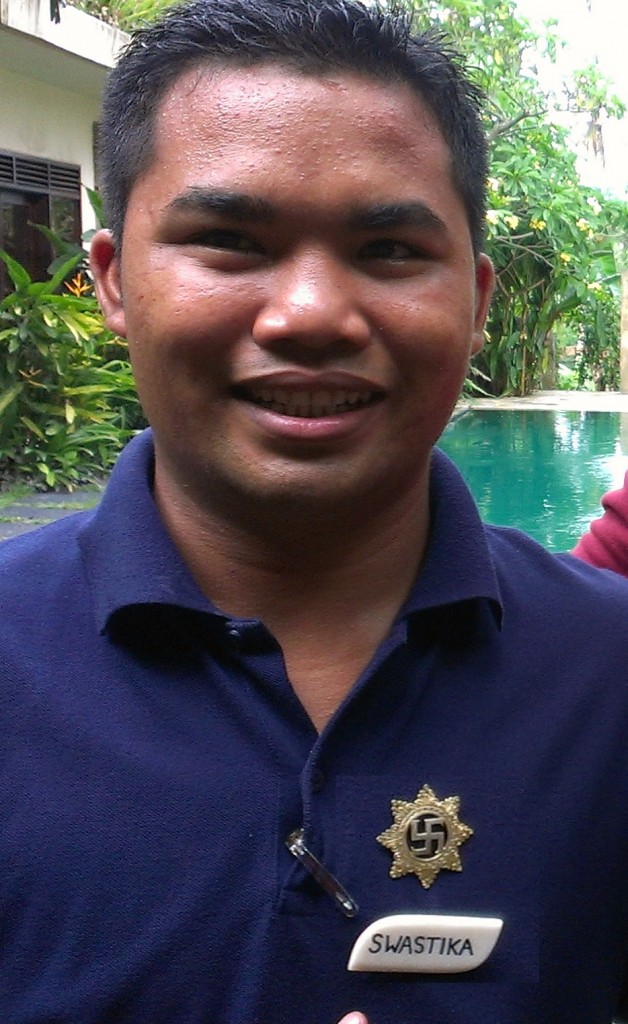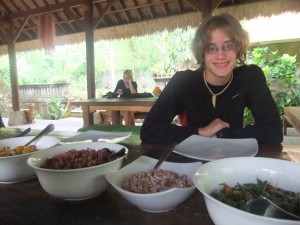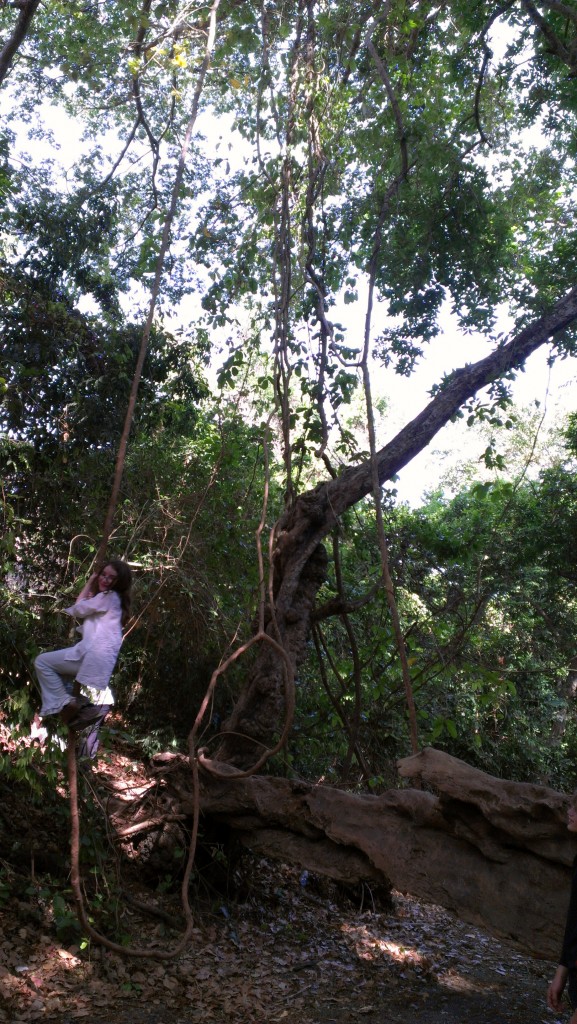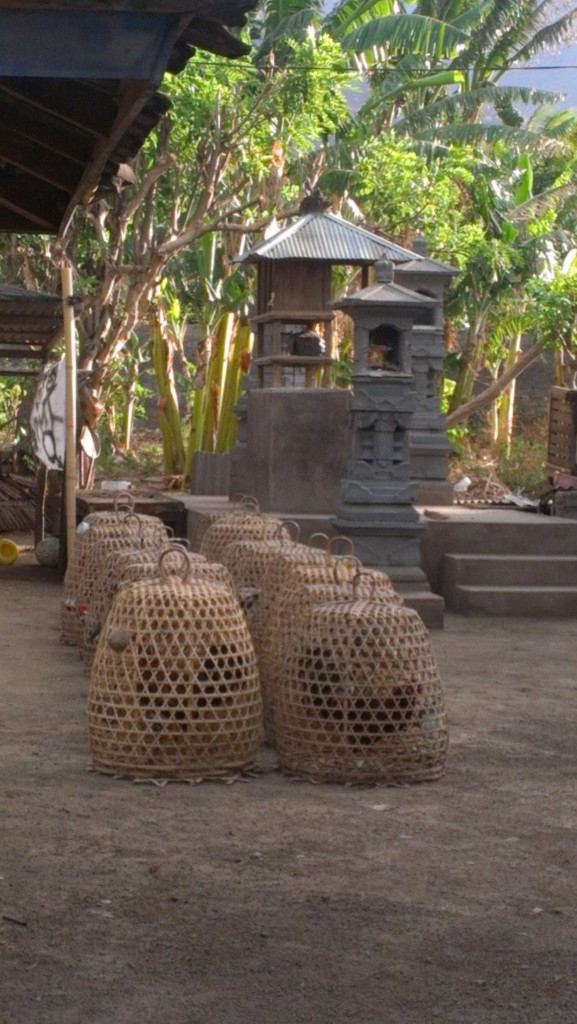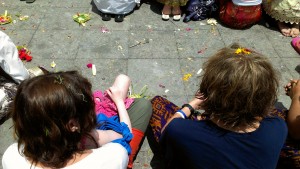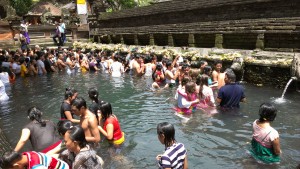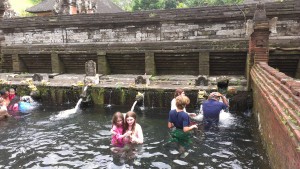Swastika
Here’s a picture of Swastika, a young man who was our tour guide and assistant in many ways in Bali. After introducing himself as Swastika he is invariably asked the meaning of his name. Here’s what he says: in Balinese Hinduism the swastika is a representation of social peace and harmony. The four legs represent the social castes each of which is dependent on the others to create a functional society. The castes are Priest/Leader, Warrior, Merchant, Farmer/Fisherman. If any of these castes is missing the social order runs aground.
There are other meanings given the swastika in Hindu belief all of them with positive connotation. It’s strange for us to see the symbol associated with peace.
It was also strange and somewhat amusing to call someone Swastika in conversation.
Getting stung for Ralph Lazar
Jemeluk Bay, Amed, Bali, Thursday 22nd Nov.
In December 2011 Ralph Lazar showed up with his new GoPro camera for action and underwater shots. He boasted of its outstanding characteristics, its flexibility, its clarity, action video, in water out water photos, fish eye lens. He jumped into the pool to demonstrate and quickly edited a movie of it all to excite us.
Suitably excited I bought one for Eva for her birthday and she brought in on our trip as we have spent much of the past two months in or under the water.
On Wednesday early evening I went snorkeling. That’s when the fish are feeding, including the sharks.
From October to December Mackeral visit the eastern shores of Bali. Among the things I saw was a large school of mackeral swimming up and down with their mouths wide open. So wide open that their gills flared. They were there because their food was there. A thick cloud of tiny crimson jelly fish.
I didn’t stay in the water long, the jelly fish stung.
But I was determined the next day to video the scene for Eva and Ralph. Yannay thought it a good idea, and shirtless he joined me. We checked that we had enough memory and then searched for the mackeral for half an hour. We found the jellyfish, or more correctly they found us, but we stayed in the water for the sake of the video. We saw damselfish eating off the coral, butterfly fish eating, some parrot fish eating. We got chased by a trigger fish. And then we saw a mass of balck damsel fish eating and above them, the bright silver reflection of the mackeral. I turned on the video. The jellyfish continued to sting. Little stings like a red ant biting. Or a light bee sting. Sting, sting. We stayed in the water and swam after the fish. They came towards us. We videoed it. They swam away. We videoed it. Up and down. An amazing sight. Hundreds of mackeral feeding on thousands of jellyfish. Yannay and I surfaced. We agreed to stay in to video some more.
For o=another hour we followed the fish. By the time the stinging became too great we swam for shore and plunged into the pool. I immediately gave Eva the GoPro to download the video so that she, Dani and Avia could see what we saw.
After three minutes the Go Pro had run out of battery.
My first massage lesson
My first massage lesson took place in Ubud, Bali on November 16, 2012. I got taught in a spa called Sang Spa by a woman named Juni for almost six hours straight. The lesson started at 10am and ended at 4:30 with a half an hour break at 1 after learning for 3 hours straight.
When I arrived at the spa at 10, I had no idea what to expect. I didn’t know what kind of massage I’d learn and I didn’t know how they’d teach me. I thought they’d first teach me theory (what muscle is where and stuff) but they said to go into a room and in that room was a person lying on a massage table with a sarong on them. Then the lesson started. Juni started demonstrating how to do the massage and at the beginning it was very awkward for me and I didn’t think I’d enjoy it because the massage included the gudius maximus (scientific word for bottom). After about 15-30 minutes of the lesson I got used to the giving the massage and enjoyed it a lot. Not even ants covering my food could destroy the fun.
After the six hours were over, I sat at the front of the spa waiting for my dad to pick me up and when he came he videoed them giving me my certificate. I am now certified to provide Balinese massage. It was a lot of fun but I don’t know how I’m going to remember how to do the massage because I don’t know who to do it on.
Video 1: watch the first 2:50 mins.
Video 2:
Avia as Tarzan – Revisited
West Bali National Park, Pemuteran, 8th Nov, 2012
Here’s Avia swinging from a Lian. “It’s fun, but it would be much more fun if Jamie was here. We could swing together.”
This plant attaches itself to the top of a seedling and grows at the same speed as the seedling. Alongside the Lian that Avia is swinging on is a 120 year old tree with attached 120 year old Lian.
I’ve also attached a picture of a Monkey Step, a relative of the Lian which looks like a rope with internal steps. All this was learned when David forced a Bird walk on his family. The bird walk was especially boring. The eight types of Kingfisher were all seen, but from the distance they all took on the generic shape of a bird. Eventually, after one and a half hours of mindless walking in extreme heat along mangroves (saltwater plants) we headed for the evergreen forest, converted the bird watching into a botanical tour and had much more fun.
Rice Growing In Bail
What is a Subak?
A Subak is a community of rice farmers. Each Subak has a leader to represent the Subak at the temple. The leaders go to the temple to set the irrigation system for the next year. This is important because the irrigation system makes sure that every field from the top of the hill to the bottom of the hill gets an equal amount of water.
The Priest
The high priest is chosen at birth by the goddess of the lake to be a human form of herself until death.There are twenty four priests and one high priest. It is the high priests job to divide the water from Lake Batur and Kintamani between the people and to decide when to farm the land, as it all has to be farmed at the same time. This is a natural pest control because if pests have no were to go to eat, they will starve and there wont be any coming to eat the crops when you are farming again.
Farmers
Rice farmers harvest their crops three times a year and make $500 a year ($1.50a day) some make no money and eat only the rice they harvest. They harvest just enough to keep themselves and their families alive. this is called subsistence farming.
The Importance of Rice
Rice growing is very important in hindu balinese community. There are rise ceremonies, offerings of rise and people put rise on their forehead and neck at the temple. Rice is a source of life for the balinese people.
The lowdown on Cockfighting
Ubud 20th November, 2012
Cockfighting sits right in the heart of Balinese culture. At the start of most major festivals cockfighting takes place in the temple. And then continues in a square outside. And it’s not simple cock fighting. These cocks have blades attached to their legs for slicing their opponent.
What’s going on?
It’s all about balance in life. Remember the evil spirits. They love it when people fight. They like to sow discord. So during festive times, when we show respect and appreciation to the good Gods of plenty, we need to balance that by appeasing the bad spirits as well.
Cock fighting replaces human fighting. It keeps the evil spirits happy and away from humans. People bet on each fight. Betting against someone’s cock is like fighting with them. So betting on cock fights too is a substitute for human fighting and social discord. If the cocks fight, the bad spirits are appeased and human relations remain pleasant.
This reasoning aside, Balinese men simply enjoy the fight and
This is a photo taken in Pemutran showing fighting cocks which are kept alone in a small woven cage. Fighting cocks are pampered like loved pets. If they lose they are thanked for their services and slaughtered. But if they win, they are highly prized.
With thanks to INenega Wira Setiasa Spd, son of Mr.Rija, Head of Village Customs (Kelian adat), Klungah Village, Sidemen.
Tirta Empul Temple, Swastika, and the Purification Ritual
Part of our Living Ritual Series :]
You can only do it at one spot in Bali. And unless you are local you won’t know what to do.Happily, we visited the temple with our new friend Swastika with whom we took part in the ceremonies.
Part 1: The objective of a visit to the Tirta Empul pond is to have the water run from the spout onto your head. This is a purifying act. (Subconsciously read Mikvah). Locals are not shy to bathe naked in village streams but here the etiquette is to wear a sarong around your waist and a shirt. (left photo)
Tirta Empul Temple was built in 926 on top of a large spring. The spring water bubbles up into a walled pond. From one of the side walls the water runs through spouts into the pond you see in the picture.
Part 2: After bathing and changing, (to Eva’s dismay, the on site changing area is a small building packed with people and dirt) we walked up to the offering section of the temple. Here a head priest (read Kohen HaGadol) sits on a low platform ringing a bell, chanting and preparing for the communal phase of the offering. People sit in rows behind the priest and we joined them (see photo on the right). Swastika took and offering plate and we went through the motions. Flower over the ear, flowers on the head, hands above head. The priests (dressed in white) walk around chanting and with a special palm frond they sprinkle water on the worshipers. Then they proffer a bowl of rice which is taken and the rice stuck on the forehead. Rice on the forehead does not suit Eva but flowers on the head do. (3 min video of ceremony coming soon)
Releasing turtles
Pemuteran, Bali
On November 7th, 2012 at around 9:30am I, with both my sisters, released three adorable three month old Olive Ridley turtles into the sea. Each one of us chose a name for our turtle and released it out into the open sea.
First, before you released your turtle, you could choose which one you wanted to release. The turtles were kept in tubs of water and were sorted out into groups. One tub for two week old turtles, one for 1 month old turtles, one for two month old turtles and three for three month old turtles. Each tub had several turtles in it but you could only choose one of the three year old turtles to free. There was also a sandpit where the turtle eggs were kept. We (my sisters and I), each chose a turtle to release and went down to the beach with them in our hands. Then, when we were at the beach we walked toward the water and stopped about half a meter from the it. From there, we gently put the turtles on the sand and let them go into the sea. I released mine first, Daniela was second and the refusing Avia, was third. She wanted to keep hers as a pet. Each one of us followed our turtles in the sea for about ten meters watching it swim and then let it go on. They were so cute!
VIDEO – to be added.
David Adds: There are five species of turtle in Indonesia, each endangered. Turtles and their eggs are used by locals for food, ritual and tourist souvenirs. The Reef Seen Turtle Hatchery Project in Pemuteran purchases turtles and their eggs from locals and fisherman in an effort to conserve them. Most of the effort of the turtle hatchery goes to educating locals on the value of sustainable exploitation of natural resources.
The local fisherman and villagers now make more money by selling turtle eggs to the project than to the market. As one turtle can lay 150 eggs, this is quite profitable for locals. As a result the local fishing industry has mandated that anyone catching a turtle should bring it to the hatchery.
The hatchery raises the turtle from egg to three month.Their opinion is that a three month turtle has more chance for survival than a newborn. Turtles breed at age 19. This project is 20 years old. The three turtles that Yannay, Daniela and Avia released are thought to be the offspring of the initial intake of eggs and caught turtles. DIvers report an increase in turtle sitings in the area. The project was founded by Chris Brown, the owner of a local dive shop.
Two week old turtles resemble little bath time turtle toys.
Recent Posts
Recent Comments
Archives
Categories
- Assignments
- Australia/New Zealand
- Avia
- Bali
- Biomes of the World
- Blog
- botanical pictures
- Cambodia
- Daniela
- David
- December
- Eva
- February
- First Nations of BC
- Hong Kong
- January
- Laos
- March
- Margherita Index
- Myanmar-Burma
- November
- October
- Origins of Oceanian People
- Pacific Northwest Biome
- Photo of the Day
- Polynesia
- Quotes
- September
- South Pacific Biome
- Thailand
- Videos
- Vietnam
- Yannay


